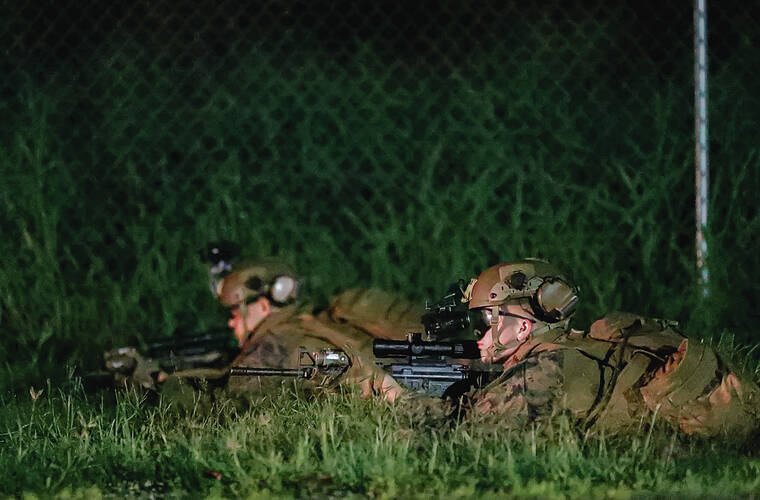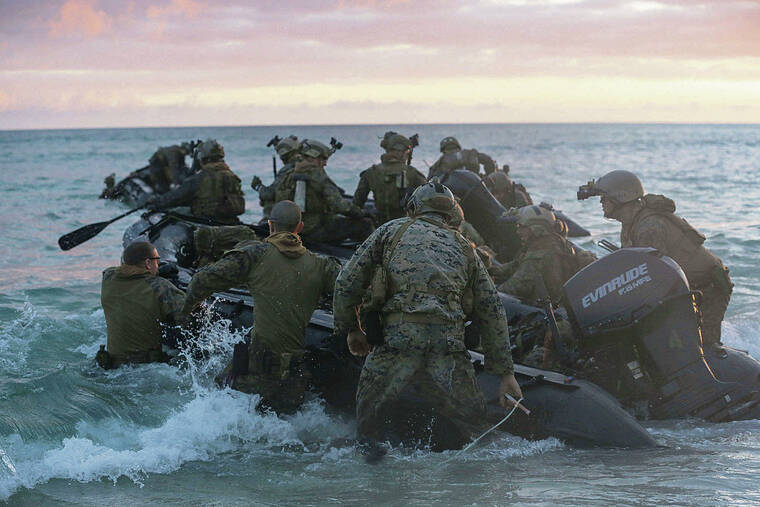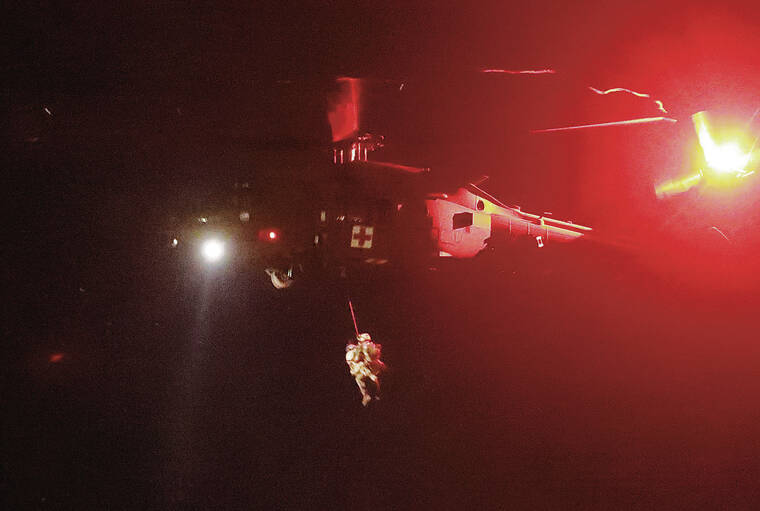A team of specially trained U.S. Marines had spent nearly
24 hours in the field watching potential targets Thursday night from afar. They carefully documented the comings and goings of the men they were watching for anything suspicious.
It was part of an ongoing exercise that troops with the Japanese-based 31st Marine Expeditionary Unit’s Maritime Raid Force have been conducting in Hawaii since last week. The scenario is set in a fictional Pacific island nation, and the Marines are hunting an enemy hiding in plain sight, what analysts have increasingly come to call a “grayzone environment” — not quite peace, but not quite war, either.
Maj. Seth Miller, the officer in charge of the Special Missions Branch of the 3rd Marine Expeditionary Force’s Expeditionary Operations Training Group, explained that in the scenario, another foreign country has moved assets into the fictional island nation after a series of natural disasters left it vulnerable, and is making efforts to extend its influence while secretly building a military infrastructure for future operations.
Once the surveillance team had gathered enough intelligence to confirm its targets, two Chinook helicopters full of Marines descended on Kalaeloa Airport with a raiding team to launch simultaneous raids on two targets: one at Coral Crater Adventure Park and another at Dogs of War Airsoft Park in Kalaeloa.
The Marines drove specialized ATVs that fit into the helicopter, rolling in on the targets at night, moving on the roads and navigating civilian traffic as they moved toward the targets.
“This provides us an opportunity to train in a realistic urban terrain populated complex … as well as also having to take into consideration civilian populations and collateral damage and minimize and things like that,” said Miller. “It adds a layer of complexity to the situation when you’re not essentially battling or fighting a declared hostile force.”
The exercise, which runs until Wednesday, has included both land and sea operations. Last week the Marines practiced boarding vessels before moving operations inland. The exercise mirrors real-life fears among some policy analysts as China extends its influence around the globe, including the Pacific.
Kiribati, an island nation south of Hawaii, in 2020 joined Beijing’s Belt and Road initiative, an arrangement in which the Chinese government finances infrastructure projects in various countries to support Chinese trade interests. Among the projects are the renovation of a World War II-era U.S. military airstrip that some analysts contend has “dual-use” plans to support both
Chinese civil and military
aircraft, though Kiribati’s current government insists there are no military dimensions to the project.
“I think you have to see this not just in the context of U.S.-China, but you have to see this in the context of grayzone — or ‘hybrid warfare’ — (it) is something that is becoming the norm globally,” said Alexander Gray, a former chief of staff for the White House National Security Council and a fellow at the American Foreign Policy Council.
What is included in “grayzone” operations is constantly being refined as the nature of modern conflict becomes more complicated.
During the Russian annexation of Ukraine’s Crimea region in 2014, the Russian government was accused of using “little green men,” Russian troops without military insignia posing as local militiamen — to seize territory. Since then the two sides have engaged in a tense border standoff with periodic bursts of violence.
In the Middle East, Iran has pursued its interests through a web of militia groups that have run candidates in political races and assassinated rival politicians and activists. In Iraq and Syria, U.S. troops and Iranian-backed militias operate in the same areas — all fighting against ISIS militants — while also periodically attacking each other with drones and rockets when tensions flair.
In the Pacific, Beijing has pursued its own strategy as tensions simmer in the South China Sea, a critical waterway through which a third of all international trade travels. Several countries have competing claims over various small islands, reefs and atolls in the region, most notably the Spratley and Paracel islands. China, for its part, asserts the entire sea is its exclusive territory.
The Chinese military has begun building docks and airstrips on some of these formations and even built man-made islands to assert its territorial claims. The Chinese military also has been accused of using “maritime militia” forces, ostensibly civilian vessels that sometimes conduct surveillance and attack other vessels from countries like Vietnam and the Philippines in order to stake out disputed territories.
Last month the government of Palau requested help from the U.S. Coast Guard in tracking a Chinese survey vessel that came into its waters in late November. Beijing has been accused of using these vessels to secretly map out other country’s territories for the Chinese military under the guise of research.
“(We don’t) have a good handle, particularly in the Chinese case, on how do these vessels play into the larger apparatus,” said Gray. “Who are they taking orders from? What is their connection to the Communist Party and the People’s Liberation Army Navy, to the state Oceanic Administration. There are a lot of gaps in our knowledge of how these these operate.”
He added that the policymakers and commanders at present lack the “type of intelligence on these vessels to be able to make that legal, and frankly diplomatic and political judgments, about what’s the appropriate way to engage. We have a long ways to go about that.”
The U.S. and China have both been pouring money into weapons programs, particularly the development of advanced hypersonic missiles. The Marine Corps itself is reorganizing its entire force, beginning with troops in Hawaii, with an emphasis on mobile missile batteries that Marines would move from island to island in the event of a conflict.
But in December, Marine Corps Commandant Gen. David Berger warned that an overemphasis on high-tech, long-range weapons systems would be a serious mistake. He argued that Marines still need to get close by to conduct surveillance and other operations to see what Chinese forces in the Pacific are actually doing.
“The standoff (with missiles) from 1,000 miles away works right into (Beijing’s) strategy,” Berger said in December during an event at a Washington-based think tank, the Center for a New American Security. “We have to be in there (with troops), we have to be close up and forward.”
The Maritime Raid Force is specially trained for such operations. It’s meant to operate out of ships to conduct sensitive operations at sea and along coastlines, whether it’s surveillance and intelligence gathering or small-scale raids.
A particular focus for military planners is the world’s littorals — areas between the open oceans and shorelines. They have emerged as a favored environment for transnational crime networks and also become the sites of conflict in regions where disputes have emerged over navigation, fishing and undersea drilling rights.
“(The littorals have) the prevalence of a civilian population that has maritime aspects to it, whether it’s fishing or seaborne commerce,. A lot of times it’s densely populated areas,” said Gray. “It’s particularly difficult for the U.S. security apparatus to respond in that type of terrain. … It just creates a lot of logistical and even legal challenges trying to operate in that environment.”
Miller said that Oahu offers unique opportunities to train for these environments. “That sort of complex, unfamiliar urban terrain is applicable to anywhere in the Indo-Pacific,” he said. But he admitted that the real-world applications are something they’re still working out. He said any operation of this sort needs to be handled in such a way that it doesn’t escalate into more conflict.
“This is something that the U.S. government is, I think in some extent, behind the curve on figuring out
the appropriate way to (counter) this,” said Gray, who said it requires a lot of different approaches involving diplomats, intelligence officers and others to weigh options with the military.
Gray noted that when it comes to challenges at sea, the Coast Guard can play a role with its mix of law enforcement, search and rescue, and military duties. “They can go in, in a way that’s not as escalatory, and they can deal with some of these hybrid threats in a way that I think could be very useful in defusing situations,” said Gray.
Berger warns that
however the military approaches challenges in the Pacific, the No. 1 priority needs to be preventing all-out war before it happens.
“(The standoff in the Pacific) is ‘what is the force that you’re going to need to fight China and win?’ To me, that equals strategy failure,” Berger said last month during the event at the Center for a New American Security. “If we’re fighting China, then our strategy has failed.”
The raid on Thursday night ended with Marines returning from their targets and driving back to the airport. When they arrived they practiced evacuating their wounded. Rescue crews from the Hawaii National Guard arrived to pull the simulated wounded into the sky before the rest of the Marines disappeared back into the darkness.






